ICD 10 CM S52.614A | Description & Clinical Information
ICD 10 S52.614A describes a specific type of fracture that occurs in the right ulnar styloid process, which is a bony projection located on the side closest to the wrist of the smaller of the two forearm bones, and is characterized by a break in the bone without any misalignment of the fracture fragments, resulting from trauma caused by various factors such as a forceful blow at the back of the wrist, a motor vehicle accident, sports activities, or falling on an outstretched extended hand, and this code is used to indicate the initial encounter for a closed fracture that is not exposed through a tear or laceration of the skin.
Official Description Of S52.614A
The ICD 10 CM book defines ICD 10 code S52.614A as:
Excludes1: traumatic amputation of forearm (S58.-)
Excludes2: fracture at wrist and hand level (S62.-)
When To Use S52.614A
The diagnosis describes by ICD 10 CM S52.614A refers to a nondisplaced fracture of the right ulnar styloid process, which is a bone located at the end of the forearm. This type of fracture occurs when the bone suffers a direct blow or an indirect force, causing it to break without disrupting its alignment.
The symptoms of a nondisplaced fracture of the right ulnar styloid process include pain, swelling, bruising, tenderness, deformity, and limited range of motion. Patients may experience pain when they try to move their arm, and the affected area may be tender to the touch. The fracture may be accompanied by swelling and bruising, and patients may notice a deformity in their arm.
Providers use a combination of patient history and physical examination to diagnose a nondisplaced fracture of the right ulnar styloid process. They may ask patients about the circumstances that led to the injury and perform a physical examination to assess the range of motion and strength of the arm. Plain X-rays may also be used to confirm the diagnosis and to determine the severity of the fracture.
In general, stable and closed fractures of the right ulnar styloid process do not require surgery. However, unstable fractures may require fixation to ensure that the bone heals in the correct position. During the fixation procedure, a surgeon will use plates, screws, or pins to hold the bone in place so that it can heal properly. Open fractures, which occur when the bone punctures the skin, require surgery to close the wound and to prevent infection.
Other treatment options for a nondisplaced fracture of the right ulnar styloid process include non-surgical methods such as the application of an ice pack to reduce swelling and pain. A splint or cast may be used to restrict limb movement and to provide support to the arm. Exercises such as stretching and strengthening movements may be recommended to improve flexibility, range of motion, and strength. Medications such as analgesics and nonsteroidal anti-inflammatory drugs may be prescribed to alleviate pain.
In general, the prognosis for a nondisplaced fracture of the right ulnar styloid process is good, and patients can expect to make a full recovery within 6 to 8 weeks with proper treatment. However, untreated fractures may result in long-term complications, including chronic pain, stiffness, and limited range of motion in the arm. Therefore, it’s crucial for patients to seek medical attention as soon as possible if they suspect they may have a fracture in their right ulnar styloid process.


